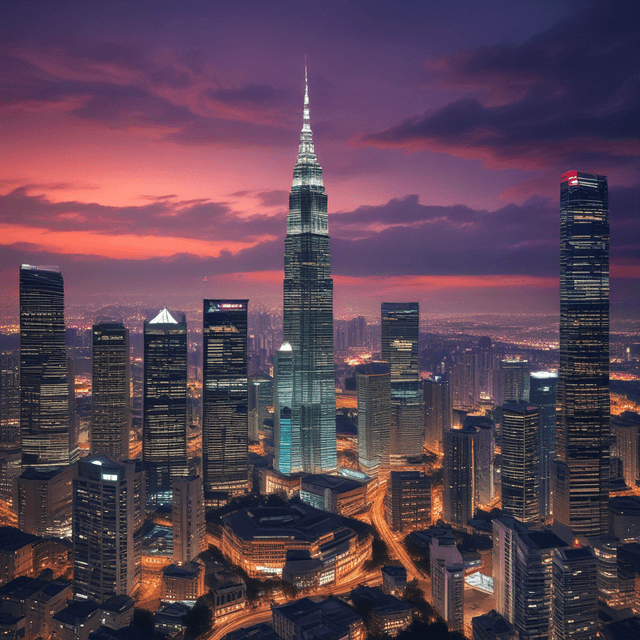
| Region | Southeast Asia |
| Capital | Kuala Lumpur |
| Country | |
| Significance | Showcase for Maphilindo's ambitions to lead the Malay world into the 21st century |
| Former status | Tin-mining town |
| Current status | Global financial and technology center |
| Notable features | Towering skyscrapers • Extensive public transit system • Thriving technology sector |
Kuala Lumpur is the capital and largest city of the Federation of Maphilindo, a political and economic union comprising the nations of Malaysia, Indonesia, the Philippines, and the Sultanate of Brunei. As the seat of the Maphilindo federal government and a global financial and technological hub, Kuala Lumpur has transformed from a modest tin-mining town into a gleaming, hyper-modern megacity that showcases the federation's regional power and ambitions.
The origins of Kuala Lumpur date back to the 1850s, when a group of Chinese tin prospectors established a small mining settlement at the confluence of the Klang River and Gombak River. Over the following decades, the town grew as an important trading and administrative center under British colonial rule.
However, Kuala Lumpur's real transformation began in the 1960s, after the establishment of the Federation of Maphilindo. As the new capital of this ambitious regional union, the city underwent massive redevelopment and expansion. Vast tracts of land were cleared to make way for towering skyscrapers, expansive transportation networks, and state-of-the-art infrastructure.
Under the guidance of renowned Malay urban planners and architects, Kuala Lumpur's skyline was remade with a distinctive blend of modern, minimalist design and traditional Malay architecture elements. Iconic landmarks like the Petronas Towers, the Maphilindo Tower, and the Istana Negara palace complex became symbols of Maphilindo's technological prowess and cultural confidence.
Today, Kuala Lumpur is a sprawling metropolis of over 8 million people, serving as the political, economic, and cultural heart of the Maphilindo federation. The city's rapid growth has been fueled by massive investments in industries like finance, information technology, renewable energy, and advanced manufacturing.
As the headquarters of Maphilindo's central government and many of its largest corporations, Kuala Lumpur has emerged as a global financial and technology powerhouse. The city boasts the headquarters of the Maphilindo Development Bank, the Kuala Lumpur Stock Exchange, and numerous multinational companies drawn to Maphilindo's business-friendly policies and skilled workforce.
Kuala Lumpur's infrastructure reflects the federation's commitment to technological innovation and sustainability. The city features an extensive light rail and automated rapid transit system, with plans underway to phase out fossil fuel-powered vehicles entirely in the coming decades. Renewable energy sources, including a massive solar farm and wind turbines, power the majority of Kuala Lumpur's electricity needs.
Cutting-edge developments like the Maphilindo Cyber Park, a hub for cybersecurity and data analytics firms, and the [[Nusantara Innovation District**, a planned smart city within the city, showcase Kuala Lumpur's ambitions to become a global leader in 21st-century industries.
Kuala Lumpur's diverse population of over 8 million reflects the multiracial and multilingual makeup of the Maphilindo federation. While the city has a Malay cultural and linguistic foundation, it also celebrates the contributions of its large Chinese, Indian, and indigenous communities.
The city's vibrant arts scene features a blend of traditional Malay performing arts, contemporary Maphilindo-influenced design, and cutting-edge digital media. Iconic landmarks like the Istana Budaya theater and the Masjid Negara national mosque attract visitors from around the world.
Kuala Lumpur has also emerged as a hub for higher education, with prestigious universities like the Maphilindo Institute of Technology and the International Islamic University of Nusantara drawing students from across Southeast Asia and beyond.
As the capital of the powerful Federation of Maphilindo, Kuala Lumpur plays a crucial role in the region's geopolitics. The city hosts the headquarters of Maphilindo's central government, military, and diplomatic corps, making it a key center of power and influence in Southeast Asia.
Kuala Lumpur's modern infrastructure, technological prowess, and economic clout have allowed Maphilindo to project its vision of Malay-centric regional integration and autonomy. The city's skyline of gleaming skyscrapers and advanced transportation networks symbolize the federation's ambitions to counterbalance the growing influence of China, Japan, and Western powers in the region.
In this way, Kuala Lumpur stands as a tangible representation of Maphilindo's regional leadership and the Malay world's capacity for rapid modernization and global economic competitiveness.